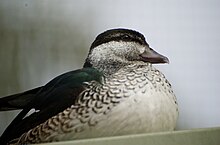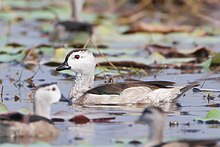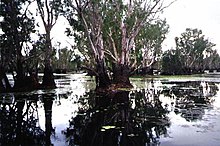Australian pygmy duck
| Australian pygmy duck | ||||||||||||
|---|---|---|---|---|---|---|---|---|---|---|---|---|

Australian pygmy duck |
||||||||||||
| Systematics | ||||||||||||
|
||||||||||||
| Scientific name | ||||||||||||
| Nettapus pulchellus | ||||||||||||
| Gould , 1842 |
The Australian pygmy duck ( Nettapus pulchellus ), also known as the green pygmy duck , is a tropical species of duck and one of the swimming ducks . It is a very small duck that has a goose-like beak and its way of life is strongly bound to water. Their distribution area is the tropical north of Australia and New Guinea.
Appearance
The Australian pygmy duck reaches a body length of 30 to 36 centimeters when fully grown. The wingspan is 48 to 60 centimeters. Males weigh an average of 310 grams, females 304. The Australian pygmy duck is a small, compact duck with a striking, shiny, bottle-green back plumage.
The males of the Australian pygmy duck have a bottle-green neck. The headstock is greenish brown. Particularly noticeable are the white cheeks and the white throat patch. Both throat and cheek patch are very variable in their extent. The beak is lead gray and has a showy, pink-horn colored nail. The wings are green and white, the belly is white with a gray tinge. The legs and feet are dark green and olive and the eyes are dark brown. In the plain dress, the male resembles the female.
The female is not dissimilar to the male. However, it lacks the green neck and the conspicuous coloration of the beak with the light nail. The head is darker and has a pale brownish stripe over the eyes. Overall, the upper half of the body is gray-brown up to eye level. Young birds, on the other hand, have plumage similar to that of females, but are less contrasting overall. The chicks are very small. They are brownish on the top of the body. The head has a dark brown head plate. The underside of the body is white. There are white spots on the fuselage and wings. The tail is relatively long. The chicks of the Australian pygmy duck differ from the chicks of the Coromandel pygmy duck by the more conspicuous dark eye stripe.
Young birds have a plumage that is very similar to the female. With them, however, the scaling from the throat to the chest is less pronounced.
The Australian pygmy duck is rarely seen on land. She moves there very clumsily. They also spend their rest phases directly on the water, for example they swim motionless between aquatic plants during the hottest part of the day. It can only be seen occasionally on sandbanks or on branches directly above the water. The flight is quick and direct. It usually flies low over the water. Frequently high-pitched whistling sounds can be heard from her.
Possible confusion with other species
Their small size and compact body make the Australian pygmy duck almost unmistakable in its range. The only species that resembles it is the Coromandel pygmy duck , which is also found in offshore Queensland. The two species, both of which belong to the genus of pygmy ducks , differ in their body color: the Coromandel pygmy duck is overall much lighter and it lacks the bottle-green dorsal plumage. The most striking difference between the males is the white face of the Coromandel pygmy duck. The females and the juveniles are more difficult to tell apart.
Distribution and existence
The main distribution area of the Australian pygmy duck is the tropical north of Australia. It is also found in the southern lowlands of New Guinea and some islands of eastern Indonesia. However, their status is particularly uncertain on these islands. On some islands, their status as a breeding bird has not yet been proven.
The Australian pygmy duck is widespread in the tropical north of Australia. But it is not common anywhere. Depending on whether suitable habitats are available, she undertakes smaller migrations to more humid regions. It may also move from the Cape York Peninsula to New Guinea. A negative effect on them is that introduced water buffalo and cattle have a negative impact on the aquatic vegetation on which the Australian pygmy duck depends as a food source. Overall, the population is estimated to be less than 10,000 individuals.
habitat
The Australian pygmy duck is limited to the coastal area and occurs here exclusively in tropical wetlands. Occasionally it can also be found in waters with brackish or even salt water. It can sometimes also be observed in the area of estuaries. It is basically a species of duck that is strongly bound to water. During the dry season it is found in fresh waters with rich floating leaf and underwater vegetation. During the rainy season, it also only uses existing waters temporarily. She avoids shallow waters as well as those with rapid water movement or too dense underwater vegetation. It can also be found on canals and billabongs and also uses water retention basins. Flooded rice fields and flooded pastureland are also used during the rainy season.
Australian pygmy ducks live in pairs or small family groups year round. During the drier season they occasionally gather in larger groups. Such troops can occasionally consist of up to 200 individuals.
food
The Australian pygmy duck feeds almost exclusively on plants. It usually takes its food directly from the surface of the water. Occasionally, however, it also digs to get to underwater plants. Dives to a depth of 30 centimeters have also been observed with her. She pulls plants to the surface of the water, which she has torn off underwater with violent head movements. Her most important food plants include water lilies ( Nymphaea gigantea and Nymphaea capensis ), whose flowers, buds and seed pods she eats. It is active at twilight and looks for its food mainly in the morning and evening hours. The feeding grounds are very small and are vigorously defended by the male. During the day, the ducks rest between the leaves of the floating vegetation. They are well camouflaged due to the green back color.
Reproduction
Since the couples are easy to recognize even in large groups during the dry season, it is assumed that they lead long-term, if not permanent, marriage. The breeding season coincides with the rainy season, otherwise relatively little is known about how the Australian pygmy duck reproduces. So far, for example, only a few nests have been found. It is assumed, however, that it mainly breeds in hollow trees close to the water. Similar to the Coromandel pygmy duck, searching for the nesting site together is part of the courtship repertoire. The eggs are oval and cream-colored. The full clutch contains about ten eggs. Only the female breeds.
Keeping in human care
Australian pygmy ducks are very rarely shown in zoos. Some of these ducks were imported to Europe as early as 1935, but the animals did not get used to it. In the Australian zoos in Perth, Sidney and Adelaide a total of 10 Australian pygmy ducks were kept from 1972, which, however, also proved to be difficult. The Australian pygmy ducks imported to Europe and North America after 1990 are animals that were caught in New Guinea. The export of wild animals is prohibited in Australia. Although the transport conditions for such wild-caught animals have improved significantly since the 1930s and the birds in tropical halls or aviaries with heated shelters can be offered much better keeping and feeding conditions, the majority of the animals also died during these imports. In 1997 there were 10 pairs that were kept for more than two years and which can therefore be considered as accustomed. However, these had not yet reproduced by 1999.
supporting documents
literature
- PJ Higgins (Ed.): Handbook of Australian, New Zealand & Antarctic Birds , Volume 1, Ratites to Ducks, Oxford University Press, Oxford 1990, ISBN 0195530683
- Janet Kear (Ed.): Ducks, Geese and Swans. Oxford University Press, 2005, ISBN 0198546459 .
- Hartmut Kolbe; Die Entenvögel der Welt , Ulmer Verlag 1999, ISBN 3-8001-7442-1
Individual evidence
- ↑ Higgins, p. 1229
- ↑ a b Kear, p. 477
- ^ Higgins, p. 1232
- ↑ Higgins, p. 1230
- ^ Higgins, p. 131
- ↑ a b c Kear, p. 478
- ^ Higgins, p. 1232
- ^ Higgins, p. 1231
- ↑ a b Kolbe, p. 183
Web links
- Nettapus pulchellus inthe IUCN 2013 Red List of Threatened Species . Listed by: BirdLife International, 2012. Retrieved February 6, 2014.



